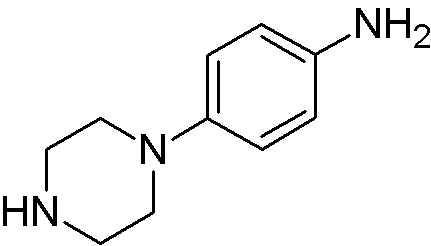4-Piperazin-1-yl-phenylamine is widely utilized in research focused on:
- Pharmaceutical Development: This compound serves as a key intermediate in the synthesis of various pharmaceuticals, particularly in developing drugs targeting neurological disorders due to its ability to interact with neurotransmitter systems.
- Agrochemical Formulations: It is used in the formulation of agrochemicals, enhancing the efficacy of pesticides and herbicides by improving their absorption and action in target organisms.
- Polymer Chemistry: The compound acts as a curing agent in epoxy resins, contributing to improved mechanical properties and chemical resistance in coatings and adhesives.
- Analytical Chemistry: It is employed as a reagent in analytical methods, such as chromatography, to help separate and identify complex mixtures in environmental and biological samples.
- Material Science: This chemical is explored in the development of novel materials, particularly in creating conductive polymers that can be used in electronic devices, offering advantages in flexibility and conductivity compared to traditional materials.
Informations générales
Propriétés
Sécurité et réglementation
Applications
4-Piperazin-1-yl-phenylamine is widely utilized in research focused on:
- Pharmaceutical Development: This compound serves as a key intermediate in the synthesis of various pharmaceuticals, particularly in developing drugs targeting neurological disorders due to its ability to interact with neurotransmitter systems.
- Agrochemical Formulations: It is used in the formulation of agrochemicals, enhancing the efficacy of pesticides and herbicides by improving their absorption and action in target organisms.
- Polymer Chemistry: The compound acts as a curing agent in epoxy resins, contributing to improved mechanical properties and chemical resistance in coatings and adhesives.
- Analytical Chemistry: It is employed as a reagent in analytical methods, such as chromatography, to help separate and identify complex mixtures in environmental and biological samples.
- Material Science: This chemical is explored in the development of novel materials, particularly in creating conductive polymers that can be used in electronic devices, offering advantages in flexibility and conductivity compared to traditional materials.
Documents
Fiches de données de sécurité (FDS)
La FDS fournit des informations de sécurité complètes sur la manipulation, le stockage et l’élimination du produit.
Spécifications du produit (PS)
Le PS fournit une description complète des propriétés du produit, notamment sa composition chimique, son état physique, sa pureté et les exigences de stockage. Il détaille également les plages de qualité acceptables et les applications prévues du produit.
Certificats d'analyse (COA)
Recherchez des certificats d'analyse (COA) en saisissant le numéro de lot du produit. Les numéros de lot et de lot se trouvent sur l'étiquette d'un produit, après les mots « Lot » ou « Lot de fabrication ».
Numéro de catalogue
Numéro de lot/série
Certificats d'origine (COO)
Ce certificat d'exploitation confirme le pays dans lequel le produit a été fabriqué, et détaille également les matériaux et composants utilisés et s'il est issu de sources naturelles, synthétiques ou autres sources spécifiques. Ce certificat peut être requis pour les douanes, le commerce et la conformité réglementaire.
Numéro de catalogue
Numéro de lot/série
Fiches de données de sécurité (FDS)
La FDS fournit des informations de sécurité complètes sur la manipulation, le stockage et l’élimination du produit.
DownloadSpécifications du produit (PS)
Le PS fournit une description complète des propriétés du produit, notamment sa composition chimique, son état physique, sa pureté et les exigences de stockage. Il détaille également les plages de qualité acceptables et les applications prévues du produit.
DownloadCertificats d'analyse (COA)
Recherchez des certificats d'analyse (COA) en saisissant le numéro de lot du produit. Les numéros de lot et de lot se trouvent sur l'étiquette d'un produit, après les mots « Lot » ou « Lot de fabrication ».
Numéro de catalogue
Numéro de lot/série
Certificats d'origine (COO)
Ce certificat d'exploitation confirme le pays dans lequel le produit a été fabriqué, et détaille également les matériaux et composants utilisés et s'il est issu de sources naturelles, synthétiques ou autres sources spécifiques. Ce certificat peut être requis pour les douanes, le commerce et la conformité réglementaire.


